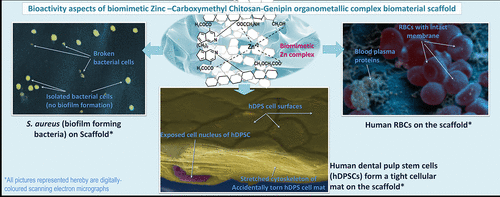当前位置:
X-MOL 学术
›
Biomacromolecules
›
论文详情
Our official English website, www.x-mol.net, welcomes your
feedback! (Note: you will need to create a separate account there.)
Evidences of Biomimetic and Nonantibiotic Characteristics of the Zinc-Carboxymethyl Chitosan-Genipin Organometallic Complex and Its Biocompatibility Aspects.
Biomacromolecules ( IF 5.5 ) Pub Date : 2019-12-17 , DOI: 10.1021/acs.biomac.9b01391 Arushi Hitendra Mishra 1 , Debasish Mishra 1
Biomacromolecules ( IF 5.5 ) Pub Date : 2019-12-17 , DOI: 10.1021/acs.biomac.9b01391 Arushi Hitendra Mishra 1 , Debasish Mishra 1
Affiliation

|
Bioinspired nonantibiotics can prove to be a better and an efficient tool to fight against antimicrobial resistance. In our study, biomaterial composed of zinc-carboxymethyl chitosan (CMC)-genipin was investigated for this purpose. Briefly, CMC was synthesized and transformed to porous scaffolds using the freeze drying method. The scaffolds were cross-linked and stabilized with genipin and zinc (2 M zinc acetate), respectively. FTIR spectroscopic data testified Zn complex formation and pointed out the absence of water molecule like that of zinc motif containing proteins. Hence, the complex may be termed as biomimetic. Genipin (0.5%) cross-linking appeared to contribute additively to the wet compressive strength of the zinc-CMC scaffolds. Biodegradation data revealed better stability of CMC-genipin-zinc scaffolds in enzymatic and nonenzymatic conditions than their redundant controls. The scaffolds seem to support adhesion and proliferation of human dental pulp stem cells and were hemocompatible to human red blood corpuscles, as revealed by scanning electron microscopy. The scaffolds were found to be antibacterial and mildly antibiofilm when tested against biofilm-forming bacteria, that is, Staphylococcus aureus (ATCC 9144), making it a potential nonantibiotic-like biomaterial. To conclude, this organometallic complex-based biomaterial may potentially serve as a weapon against antimicrobial resistance. Furthermore, the biomaterial potentially finds its application in dental, maxillofacial, and orthopedic tissue engineering applications.
中文翻译:

锌-羧甲基壳聚糖-Genipin有机金属复合物的仿生和非抗生素特性及其生物相容性方面的证据。
受生物启发的非抗生素可以证明是对抗抗菌素耐药性的更好,有效的工具。在我们的研究中,为此目的研究了由锌-羧甲基壳聚糖(CMC)-京尼平组成的生物材料。简而言之,使用冷冻干燥法合成了CMC并转化为多孔支架。支架分别用京尼平和锌(2 M醋酸锌)交联并稳定。FTIR光谱数据证实了锌络合物的形成,并指出了不存在像锌基序蛋白一样的水分子。因此,该复合物可以被称为仿生物质。Genipin(0.5%)交联似乎对锌-CMC支架的湿抗压强度具有附加作用。生物降解数据显示,CMC-genipin-锌支架在酶促和非酶促条件下的稳定性均优于其多余的对照。支架似乎支持人牙髓干细胞的粘附和增殖,并且与人红血球具有血液相容性,如通过扫描电子显微镜所揭示的。当针对形成生物膜的细菌,即金黄色葡萄球菌(ATCC 9144)进行测试时,发现该支架具有抗菌性和适度的生物膜,使其成为一种潜在的非抗生素类生物材料。总而言之,这种基于有机金属配合物的生物材料可能会潜在地成为抗药性的武器。此外,该生物材料有可能在牙科,颌面部和整形外科组织工程应用中找到其应用。支架似乎支持人牙髓干细胞的粘附和增殖,并且与人红血球具有血液相容性,如通过扫描电子显微镜所揭示的。当针对形成生物膜的细菌,即金黄色葡萄球菌(ATCC 9144)进行测试时,发现该支架具有抗菌性和适度的生物膜,使其成为一种潜在的非抗生素类生物材料。总而言之,这种基于有机金属配合物的生物材料可能会潜在地成为抗药性的武器。此外,该生物材料有可能在牙科,颌面部和整形外科组织工程应用中找到其应用。支架似乎支持人牙髓干细胞的粘附和增殖,并且与人红血球具有血液相容性,如通过扫描电子显微镜所揭示的。当针对形成生物膜的细菌,即金黄色葡萄球菌(ATCC 9144)进行测试时,发现该支架具有抗菌性和适度的生物膜,使其成为一种潜在的非抗生素类生物材料。总而言之,这种基于有机金属配合物的生物材料可能会潜在地成为抗药性的武器。此外,该生物材料有可能在牙科,颌面部和整形外科组织工程应用中找到其应用。当针对形成生物膜的细菌,即金黄色葡萄球菌(ATCC 9144)进行测试时,发现该支架具有抗菌性和适度的生物膜,使其成为一种潜在的非抗生素类生物材料。总而言之,这种基于有机金属配合物的生物材料可能潜在地成为抵抗抗菌素耐药性的武器。此外,该生物材料有可能在牙科,颌面部和整形外科组织工程应用中找到其应用。当针对形成生物膜的细菌,即金黄色葡萄球菌(ATCC 9144)进行测试时,发现该支架具有抗菌性和适度的生物膜,使其成为一种潜在的非抗生素类生物材料。总而言之,这种基于有机金属配合物的生物材料可能会潜在地成为抗药性的武器。此外,该生物材料有可能在牙科,颌面部和整形外科组织工程应用中找到其应用。
更新日期:2019-12-18
中文翻译:

锌-羧甲基壳聚糖-Genipin有机金属复合物的仿生和非抗生素特性及其生物相容性方面的证据。
受生物启发的非抗生素可以证明是对抗抗菌素耐药性的更好,有效的工具。在我们的研究中,为此目的研究了由锌-羧甲基壳聚糖(CMC)-京尼平组成的生物材料。简而言之,使用冷冻干燥法合成了CMC并转化为多孔支架。支架分别用京尼平和锌(2 M醋酸锌)交联并稳定。FTIR光谱数据证实了锌络合物的形成,并指出了不存在像锌基序蛋白一样的水分子。因此,该复合物可以被称为仿生物质。Genipin(0.5%)交联似乎对锌-CMC支架的湿抗压强度具有附加作用。生物降解数据显示,CMC-genipin-锌支架在酶促和非酶促条件下的稳定性均优于其多余的对照。支架似乎支持人牙髓干细胞的粘附和增殖,并且与人红血球具有血液相容性,如通过扫描电子显微镜所揭示的。当针对形成生物膜的细菌,即金黄色葡萄球菌(ATCC 9144)进行测试时,发现该支架具有抗菌性和适度的生物膜,使其成为一种潜在的非抗生素类生物材料。总而言之,这种基于有机金属配合物的生物材料可能会潜在地成为抗药性的武器。此外,该生物材料有可能在牙科,颌面部和整形外科组织工程应用中找到其应用。支架似乎支持人牙髓干细胞的粘附和增殖,并且与人红血球具有血液相容性,如通过扫描电子显微镜所揭示的。当针对形成生物膜的细菌,即金黄色葡萄球菌(ATCC 9144)进行测试时,发现该支架具有抗菌性和适度的生物膜,使其成为一种潜在的非抗生素类生物材料。总而言之,这种基于有机金属配合物的生物材料可能会潜在地成为抗药性的武器。此外,该生物材料有可能在牙科,颌面部和整形外科组织工程应用中找到其应用。支架似乎支持人牙髓干细胞的粘附和增殖,并且与人红血球具有血液相容性,如通过扫描电子显微镜所揭示的。当针对形成生物膜的细菌,即金黄色葡萄球菌(ATCC 9144)进行测试时,发现该支架具有抗菌性和适度的生物膜,使其成为一种潜在的非抗生素类生物材料。总而言之,这种基于有机金属配合物的生物材料可能会潜在地成为抗药性的武器。此外,该生物材料有可能在牙科,颌面部和整形外科组织工程应用中找到其应用。当针对形成生物膜的细菌,即金黄色葡萄球菌(ATCC 9144)进行测试时,发现该支架具有抗菌性和适度的生物膜,使其成为一种潜在的非抗生素类生物材料。总而言之,这种基于有机金属配合物的生物材料可能潜在地成为抵抗抗菌素耐药性的武器。此外,该生物材料有可能在牙科,颌面部和整形外科组织工程应用中找到其应用。当针对形成生物膜的细菌,即金黄色葡萄球菌(ATCC 9144)进行测试时,发现该支架具有抗菌性和适度的生物膜,使其成为一种潜在的非抗生素类生物材料。总而言之,这种基于有机金属配合物的生物材料可能会潜在地成为抗药性的武器。此外,该生物材料有可能在牙科,颌面部和整形外科组织工程应用中找到其应用。











































 京公网安备 11010802027423号
京公网安备 11010802027423号